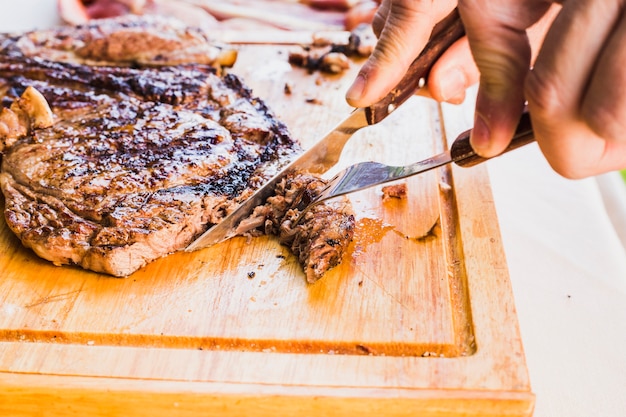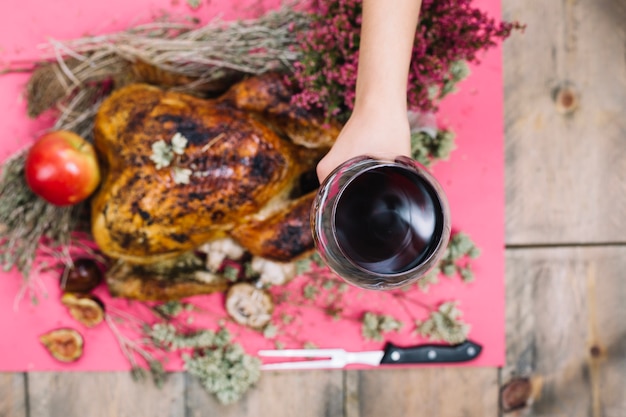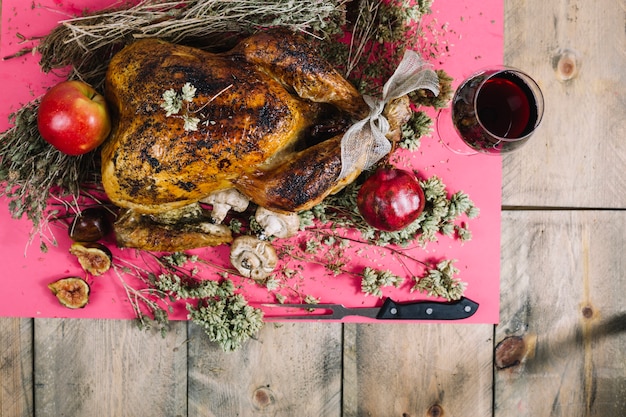You've got a beautiful piece of pork, ready to be transformed into a delicious roast. But you're staring at the recipe, wondering how long on earth it's going to take to cook. Don't worry, we've all been there, trying to figure out the perfect cooking time for a juicy, flavour-packed pork roast. This guide is your one-stop shop for all things pork roast cooking times. I'm going to walk you through everything, from choosing the right cut to nailing the perfect temperature, and even throw in some personal tips and tricks I've learned along the way.
Part 1: Picking Your perfect pork roast

Choosing the Right Cut: A Journey of Flavour
The first step to a delicious pork roast is choosing the right cut. It can be a bit overwhelming with all the options, but I'm here to help you navigate this exciting culinary adventure. Let's break down the most popular cuts and explore their unique flavour profiles:
- Shoulder: Think hearty and rustic. This classic choice, often called a Boston Butt, is a bit more fatty than other cuts. This fat renders down during cooking, creating a luscious, melt-in-your-mouth texture and rich flavour. It's a great option for a crowd-pleasing roast.
- Loin: A leaner cut with a delicate, slightly sweet flavour. The loin is perfect if you want a roast that's easier to slice and serve. It's often used for roasts like pork tenderloin, which cooks quickly and is excellent for smaller gatherings.
- Tenderloin: This is the crown jewel of pork cuts, known for its exquisite tenderness. It's a very lean cut, so it's essential to cook it carefully to avoid over-drying. The tenderloin is best for special occasions and smaller servings, as it cooks quickly and has a delicate, almost buttery flavour.
- spare ribs: For true pork lovers, spare ribs are a real treat. They are exceptionally fatty and flavourful, perfect for long, slow cooking. They can be roasted, but most often, they're cooked low and slow in a smoker or oven, resulting in tender, succulent meat and a crispy, flavorful bark.
My personal favourite? I'm a big fan of the shoulder. It's the most versatile, and it always turns out perfectly tender and juicy. The rich flavour and forgiving nature make it ideal for both casual weeknight dinners and festive gatherings.
Assessing the Size and Weight: A Hands-on Approach
Once you've chosen your cut, the next step is to assess the size and weight. This is crucial for determining the cooking time. It's time to get a little hands-on, folks!
- Measure the length and width: This will give you a rough idea of the size of the roast. Think of it like gauging the surface area.
- Weigh the roast: A kitchen scale is a lifesaver here. You'll need the weight to calculate the cooking time. This gives you a more accurate measurement of the roast's overall volume.
- Don't forget to account for bone: A bone-in roast will take longer to cook than a boneless one because the bone retains heat and slows down the cooking process.
Don't be afraid to get your hands dirty, folks! Feel the weight of the roast in your hands. You can feel the difference between a lean cut and a fatty one. This hands-on approach will help you understand the roast you're working with and adjust your cooking time accordingly.
Part 2: Knowing Your Oven and Understanding Temperature

Oven Types and Temperature Variations: A Tale of Two Ovens
We all have different ovens at home. Some are gas, some electric, and some even have fancy convection settings. All these factors play a role in how long it takes to cook a pork roast. Remember:
- Gas ovens tend to run a bit hotter than electric ovens: So you might need to adjust your cooking time a little. Keep an eye on the roast and adjust the cooking time accordingly.
- Convection ovens cook faster: This is because they circulate the hot air around the roast, promoting even cooking. You might need to reduce your cooking time by 15-20%. Always check your oven's manual for specific instructions.
I learned this the hard way! Once I cooked a pork roast in my friend's convection oven, thinking it would take the same amount of time as my regular oven. Let's just say it ended up a little well-done... Lesson learned! Always check the oven type and adjust accordingly!
The Importance of a meat thermometer: Your Culinary Compass
Now, I can't stress this enough - a meat thermometer is your absolute best friend when it comes to cooking pork. Pork can be tricky. Undercooked, it's not safe to eat. Overcooked, it can dry out and become tough. The solution? The trusty meat thermometer!
- The "Safe" Temperature: For pork, you want to aim for an internal temperature of 145°F (63°C). This is the temperature at which the pork is safe to eat, and it ensures that it's cooked through. The thermometer ensures safety and gives you peace of mind.
I used to rely on just the time, but I've learned that the only way to know for sure is to use a thermometer. It's the ultimate peace of mind, knowing your pork is cooked perfectly.
Part 3: Cooking Time: The Breakdown

General Cooking Times for Pork Roasts: A Starting Point
Here's a handy table showing general cooking times for different sizes and weights of pork roasts:
| Weight | Cooking Time |
|---|---|
| 2-3 lbs | 1.5-2 hours |
| 4-5 lbs | 2-2.5 hours |
| 6-7 lbs | 2.5-3 hours |
| 8-9 lbs | 3-3.5 hours |
These are just rough estimates. Remember, the actual cooking time can vary based on the factors we've discussed. This is just a starting point. Always check the internal temperature with a meat thermometer to ensure it's cooked to the desired doneness.
Adjusting Cooking Time Based on Size and Weight: A Matter of Shape
Here's the thing about pork roast cooking times: it's not just about the weight, it's also about the shape. A smaller, thicker roast will cook faster than a larger, thinner one. This is why it's crucial to take both the size and weight into account. Think of it like a puzzle; you're trying to calculate the volume of heat the roast will need to absorb.
Let's say you have a 5 lb roast. Looking at the table, you'd expect it to take around 2-2.5 hours. But if your roast is quite thin, you might need to reduce the cooking time by 15-20 minutes. If it's thick and dense, it might take a little longer.
Don't Forget the Resting Time: Unlocking Juicy Perfection
Okay, you've got the roast out of the oven, it's looking perfect, but you can't just dive in! Resting is crucial. This allows the juices to redistribute throughout the roast, resulting in a more tender and juicy final product. I learned this the hard way when I tried to slice into a hot roast and all the juices ran out.
The general rule of thumb is to rest the roast for 15-20 minutes before carving. Cover it loosely with foil to keep it warm. This allows the internal temperature to even out, so when you slice, the juices stay locked in.
Part 4: The Art of Roasting: Tips and Tricks
Seasoning Your Pork Roast: A Symphony of Flavors
Now, it's time to add some flavour. Pork is a blank canvas for flavour. I love to use a simple combination of salt, pepper, and garlic powder, but the options are endless. Here are some other flavour combinations you might enjoy:
- Mediterranean: Rosemary, thyme, oregano, lemon zest, garlic. These herbs and spices bring a bright, citrusy flavour that complements the rich pork perfectly.
- Asian Inspired: Ginger, garlic, soy sauce, sesame oil, five spice powder. This combination adds a savoury and slightly sweet flavour profile with a hint of umami.
- Cajun: Paprika, cayenne pepper, garlic powder, onion powder, black pepper. For a spicy kick, try this Cajun blend, which adds a warmth and depth of flavour to the roast.
Don't be afraid to get creative! Use what you like. You can also rub the roast with a little bit of olive oil or butter to help the seasonings stick. The fat will help the spices adhere and create a beautiful, crispy crust.
roasting techniques: From Simple to Fancy
There are a few different ways you can roast your pork. Here are some tried-and-true methods to make your roast perfect:
- Simple Roasting: This is the classic method, simply placing the roast in a roasting pan and cooking it in the oven. It's straightforward, reliable, and allows the roast to cook evenly.
- Roast with Vegetables: Add some chopped vegetables to the roasting pan with your roast. This adds flavour and helps to keep the roast moist. The vegetables release their juices, creating a delicious sauce for the roast.
- slow roasting: Cook your roast at a lower temperature for a longer period of time. This results in a super tender and juicy roast, especially with fatty cuts like the shoulder. The low and slow method breaks down the connective tissue, making the meat melt-in-your-mouth tender.
I love the slow roast method! It's so easy and it always turns out amazing. It's a forgiving method, allowing you to relax and enjoy the process.
Part 5: Mastering the Pork Roast: Expert Tips
The Importance of Basting: Keeping it Moist and Flavorful
Basting is a simple but effective way to keep your roast juicy and flavorful. It's as simple as pouring the pan juices over the roast during cooking. This helps to create a beautiful crispy crust and keeps the meat moist.
- Use a basting spoon: I find this the easiest way to pour the juices over the roast. It allows you to control the flow and avoid making a mess.
- Baste every 30-45 minutes: This will help to keep the roast from drying out. The more you baste, the more evenly the roast cooks and the more flavour it develops.
- Add some flavour: For extra flavour, you can mix the pan juices with some wine or broth. This adds another layer of complexity to the roast's flavour.
Dealing with Fat: A Balanced Approach
Okay, let's be honest, pork can be a little bit fatty. But don't worry, there are ways to deal with it.
- Trim the fat: Before roasting, you can trim off some of the excess fat. But don't trim it all off - the fat helps to keep the roast moist and flavorful. Trim about ?? inch of fat to ensure a crispy crust and reduce the overall fat content.
- Use a roasting rack: A roasting rack helps to elevate the roast and allows the fat to drain off. This prevents the roast from sitting in its own fat, promoting even cooking and a crispier exterior.
I like to leave a bit of fat on, but I use a roasting rack to make sure it drains off properly. It makes for a less greasy and more flavorful roast.
Part 6: Beyond the Roast: Delicious side dishes
Okay, you've got the perfect pork roast. Now you need some delicious sides to go with it. Here are a few ideas to get you started:
- Roasted Vegetables: Potatoes, carrots, onions, and Brussels sprouts are all excellent choices. Roasting the vegetables alongside the pork adds depth of flavour and complements the richness of the meat.
- mashed potatoes: Creamy and comforting, a classic for a reason! Mashed potatoes provide a comforting counterpoint to the savory pork roast, creating a well-rounded meal.
- Stuffing: A traditional side that's always a hit. Stuffing, often made with bread, vegetables, and herbs, adds a comforting and flavorful element to the table.
- Gravy: A must-have for any pork roast! Gravy, made from the pan juices, adds richness and moisture to the meal. It also enhances the overall flavor profile of the dish.
I love to make a big platter of roasted vegetables and mashed potatoes. It's a simple and satisfying combination that goes perfectly with a pork roast.
Part 7: Serving Your Pork Roast with Style
The big moment is here: it's time to serve your masterpiece! You've put in the time and effort, so make it a special occasion.
- Carve the roast beautifully: Evenly slice the roast across the grain for tender, juicy bites. This ensures that the roast is cut against the muscle fibers, resulting in a tender and more palatable texture.
- Arrange the roast on a platter: Display your roast with pride! A beautiful platter will elevate the presentation and make the roast look even more impressive.
- Add some finishing touches: Garnish with fresh herbs or a drizzle of sauce for extra flair. A simple sprig of rosemary or a drizzle of pan sauce adds a touch of elegance and enhances the visual appeal of the dish.
I like to carve the roast tableside, so everyone can see the beautiful pink inside. It's always a crowd-pleaser!
Part 8: Leftovers? No Problem!
Leftover pork roast? Don't even think about throwing it away! It's the perfect base for all sorts of delicious dishes.
- Pork sandwiches: Slice the roast thin and pile it onto bread with your favourite toppings. A simple sandwich with a tangy mustard or a more elaborate creation with roasted peppers and cheese is a delicious way to use leftover roast.
- Pork salad: Dice the roast and mix it with your favourite greens and dressing. A hearty salad with a vinaigrette or a creamy dressing is a light and refreshing way to enjoy leftover roast.
- Pork soup: Use the leftover roast to make a hearty and flavorful soup. The roast adds richness and body to the soup, creating a satisfying and comforting meal.
My favourite leftover pork recipe? Pork tacos! It's a quick and easy way to use up the leftovers, and it's always a hit with the family.
FAQs
Q1: How do I know if my pork roast is cooked?
The best way to know if your pork roast is cooked is to use a meat thermometer. Insert the thermometer into the thickest part of the roast, making sure it doesn't touch any bones. It should register 145°F (63°C). If you don't have a meat thermometer, you can check for doneness by pressing on the roast; it should feel firm and springy.
Q2: What if my pork roast is overcooked?
If your pork roast is overcooked, it might be dry and tough. Don't worry, there are a few things you can do. You can add some moisture back in by making a gravy or sauce, or by serving it with a side dish that's rich in moisture, like mashed potatoes or stuffing.
Q3: Can I freeze pork roast?
Yes, you can freeze pork roast. It's best to freeze it before it's cooked. Wrap it tightly in plastic wrap and then in foil, or use a freezer-safe bag. It can be frozen for up to 3 months. Once frozen, thaw the roast in the refrigerator before cooking.
Q4: How do I reheat a pork roast?
You can reheat a pork roast in the oven or in the microwave. If you're reheating it in the oven, cover it with foil to prevent it from drying out. If you're reheating it in the microwave, use a microwave-safe dish and cover it with a lid or plastic wrap. Reheating in the oven at a low temperature is often the best way to ensure the roast stays moist and tender.
Q5: What are some tips for making a delicious pork roast?
Here are a few tips for making a delicious pork roast:
- Season generously: Don't be afraid to use plenty of seasoning. Pork is a blank canvas for flavour!
- Use a roasting rack: This helps to elevate the roast and allows the fat to drain off.
- Baste frequently: Basting the roast with pan juices helps to keep it moist and flavorful.
- Let it rest: Before carving, let the roast rest for 15-20 minutes. This allows the juices to redistribute, resulting in a more tender and juicy roast.
So there you have it! With this guide in hand, you're well on your way to mastering the art of pork roast cooking. Go forth, get those ovens preheated, and enjoy a delicious, homemade pork roast!
Everyone is watching

How to Cook Frozen Lobster Tails Perfectly: A Step-by-Step Guide
RecipesLobster. Just the word conjures up images of lavish meals, special occasions, and a taste of luxury. But let's...

Pigs in a Blanket Cooking Time: How Long to Bake for Perfect Results
RecipesAh, pigs in a blanket. Just the name conjures up images of those delightful little parcels of crispy pastry en...

Pork Fillet Cooking Time: How Long to Cook It Perfectly
RecipesPork fillet, or tenderloin as it's sometimes called, is a real favourite in our house. It's so versatile, and...

The Ultimate Guide to Tender, Juicy Pulled Pork
RecipesRight, let's talk pulled pork. It's one of those dishes that just screams "comfort food," doesn't it? I mean...

The Ultimate Guide to Cooking Sweet Potatoes: From Roasting to Mashing
RecipesSweet potatoes. Just the name conjures up images of warm, comforting dishes, bursts of vibrant color, and a to...
